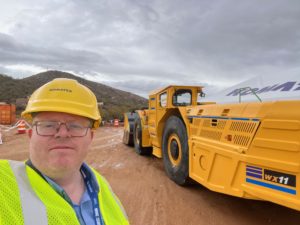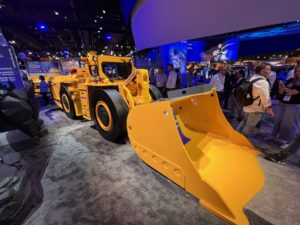Earlier this year, IM Editorial Director Paul Moore was able to see the Komatsu WX04B battery electric LHD in action as part of a sneak preview at a Komatsu customer event at its test mine, which is located at the University of Arizona’s San Xavier Mining Laboratory near Tucson, Arizona.
Doug Eamer, Komatsu Senior VP of Hard Rock Mining: “This is our first battery electric LHD and features our dynamic battery swap system. You have your battery pod at the rear – it is an ESS or Energy Storage System. When I say the swapping is dynamic, the vehicle has onboard power to be able to offload the depleted battery and pick up a charged battery. It is a patented ground level system – which is allowed for in the shape and design of the ESS body and the departure angle from the LHD.”
IM Editorial Director Paul Moore at the San Xavier Mining Laboratory earlier this year

Competitor battery swap systems are vertical lifts, and use electro-hydraulic cylinders to support the battery and/or require the battery to be deposited into a dedicated tray or flat concrete pad. Eamer states: “With our design, the battery can be unloaded onto uneven ground, even on a negative grade off-set from where the machine chassis is and even where there are some loose rocks – our system still allows the pod to be picked up, pulled on and locked into position.”
The WX04B went through months of testing earlier this year. The proof of concept machine is significant because it forms the basis for all of Komatsu’s planned larger LHDs moving forward – the next iteration of which will be a 7 t LHD set to be launched in 2025/2026. That machine will also have ground level battery swap like the WX04B plus it will have an on-board tramming battery pack. In addition to the 7 t machine, Komatsu has plans to introduce larger battery electric LHDs in the future.
The company is also continuing the development of hybrid LHDs to offer customers who want that flexibility before going to full battery. Komatsu will also look at introducing battery electric models for its underground trucks. In addition, with the recent GHH acquisition, there will be synergies with some of its models and designs as well.
These design attributes are intended to keep it as simple as possible to make the machines as flexible as possible across all types of hard rock mines including small and mid-tier operations including narrow vein sites. And the ground level system means swapping batteries can be done in most parts of the mine – it doesn’t need a dedicated and purpose-built swapping area. Eamer: “We went through many iterations of our battery LHD design and the feedback from early BEV adopter customers was always – we want robust and simple, so that is what we have done.” In addition, competitor batteries need auxiliary cooling for thermal management – the Komatsu battery thermal management system is integrated into the ESS so that auxiliary cooling is not needed.
Komatsu WX04B and batter charger at MINExpo 2024 in September


Finally, the system is charging port agnostic – it has a CCS2 port, meaning the customer has the option to use a third-party charger. Komatsu has its own vehicle-agnostic 150 kW battery charger that it developed for the WX04B which has built in transformers and has been engineered specifically for underground hard rock mining. Its compact, rugged design allows the charger to be easily moved and deployed and is available in a variety of input voltage ranges to meet global demands.
The packs themselves have Proterra battery modules – in the WX04B there are six of them – with a total energy density of 165 kW/h which is twice that of competitors in this class meaning theoretically it can run for twice as long. It can operate for up to four hours in a typical underground LHD duty application with the charge cycle around two hours. The machine can be opportunity charged to replenish the battery during shift changes or operator lunch breaks without removing the ESS.
The battery management system acts like the brain of the battery system as it continuously controls and monitors the battery cells. On-board telemetry allows for battery information to be continuously monitored in real time down to the cell level which can trigger alarms and aid with troubleshooting and potential issues. The WX04B has a tramming battery pack with plenty of power to tram without a pod attached as well as to swap the pods.
Komatsu designed the WX04B based on a common and proven platform with its WX04 diesel machine utilising common elements such as Komatsu’s industry-proven Z-link, reinforced boom design and optimised geometry which offer excellent reliability, durability and productivity. The operator cab is ROPS/FOPS-certified, with generous space and comfort. A fully enclosed, environmentally controlled option includes open-door safety interlocks that activate brakes while deactivating the boom, bucket and steering functions.
The WX04B battery electric LHD and 150 kW battery charger were both recently featured in Komatsu’s booth at MINExpo 2024 in Las Vegas, Nevada.











